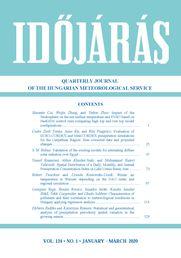IDŐJÁRÁS - angol nyelvű folyóirat
Vol. 124, No. 1 * Pages 1–141 * January - March 2020
 |
|
 letöltés [pdf: 24504 KB]
letöltés [pdf: 24504 KB]
Evaluation of EURO-CORDEX and Med-CORDEX precipitation simulations for the Carpathian Region: Bias corrected data and projected changes
Csaba Zsolt Torma, Anna Kis, and Rita Pongrácz
DOI:10.28974/idojaras.2020.1.2 (p. 25–)
Csaba Zsolt Torma, Anna Kis, and Rita Pongrácz
DOI:10.28974/idojaras.2020.1.2 (p. 25–)
IDŐJÁRÁS folyóirat

Az IDŐJÁRÁS a HungaroMet Nonprofit Zrt. negyedévenként megjelenő angol nyelvű folyóirata
Megrendelhető a journal.idojaras@met.hu címen.
A szerzőknek szánt útmutató itt olvasható.
Megrendelhető a journal.idojaras@met.hu címen.
A szerzőknek szánt útmutató itt olvasható.









